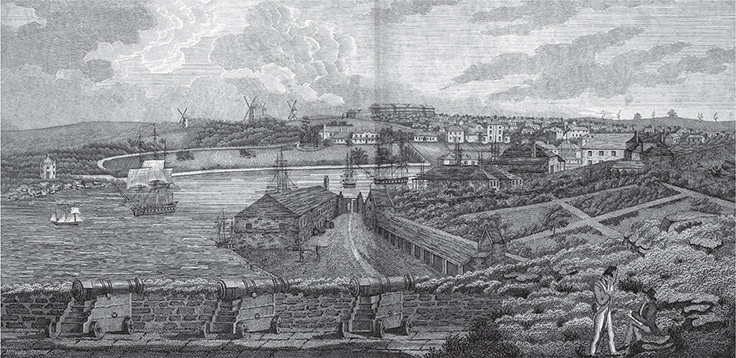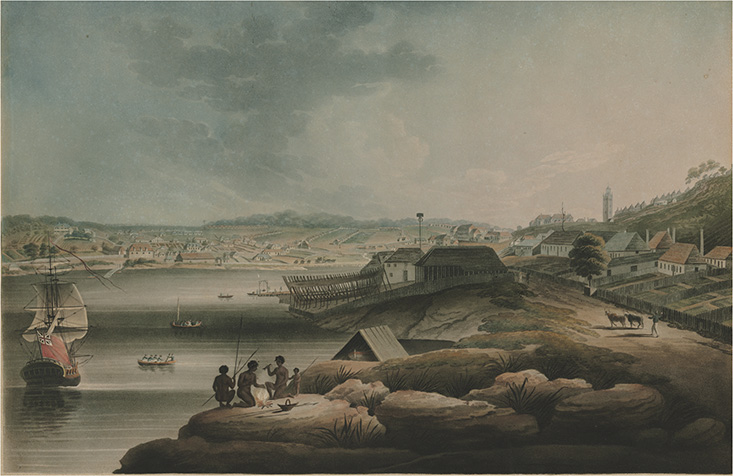
View of Sydney from Dawes Battery (Dawes Point). Drawn by Captain Wallis of the 46th Regiment and published in 1820. Courtesy of the State Library of New South Wales.
5 An Unusual Charge for Murder
On 10 October, two days before the criminal court was due to meet, the colony’s Judge-Advocate, Richard Dore, was preparing the indictments (charges) against the five Hawkesbury men awaiting trial in Sydney. Under the Letters Patent for the Criminal Court it was Dore’s responsibility to write down the charges and read them to the prisoners when the court opened. As he read the depositions taken on 24 and 25 September he had difficulty deciding exactly what the charge should be. Had the deaths been of two white people he most certainly would not have had any misgivings. The charge would be murder. But this time he balked over writing the words. But how else could he write the charge?
Dore had just sixteen months experience in the colony, but he was well appraised with the Governor’s determination on this subject—the men should be charged as if they had murdered two white people. Earlier that year, in February, Dore had presided over the trial of Thomas Hewitt. The charge he had written then was ‘the wilful murder of Willi Cuthie (a native)’.1 The trial miscarried because Dore could not allow the Aboriginal witness to give evidence. So there was no prosecution case to answer because the only potential witness was also a native, Willi Cuthie’s wife.

View of Sydney from Dawes Battery (Dawes Point). Drawn by Captain Wallis of the 46th Regiment and published in 1820. Courtesy of the State Library of New South Wales.
The record of Hewitt’s trial that day is extraordinarily brief. Dore read out the charge of wilful murder to Hewitt who pleaded ‘not guilty’. But the trial could go no further. The record then states:
No Prosecutor appearing and the native widow of the deceased being incapacitated from giving such Testimony as could be admissible in Law to affect the Life of the Prisoner he was by the Court. Acquitted.
The admissibility of evidence was Dore’s call to make—his decision. Dore had not recorded his reasons for not admitting Cuthie’s widow to the stand, but it was probably the same as that expressed five years later by another of the colony’s judge-advocates, Richard Atkins.2 It is a subject that has since been of interest to law historians.3 Dore’s ruling was based on one clear fact. Willi Cuthie’s widow could not take the oath, a preliminary necessity in giving evidence. As she did not believe in God (the God represented by the Bible she would hold), swearing to tell the truth would mean nothing to her.
We know almost nothing of the circumstances of Cuthie’s murder, except, as John Hunter later noted, Willi Cuthie was shot at Botany Bay.4 Did Cuthie’s wife complain to the Governor? Was the charge of wilful murder made at Hunter’s request? Because of the mistrial, in some kind of compromise, Hewitt was instead charged with a lesser crime, that of being a rogue and a vagabond. Found guilty on the evidence of the provost marshal and a constable, he was sentenced to work in the gaol gang for twelve months and, for the sake of demonstration, was to receive 300 lashes before an assembled crowd of Aborigines. The flogging was to be a show as much as a punishment. It was much as Governor Phillip had ordered before, demonstrating that the Governor was so displeased at the murder that the man was given severe physical punishment. If Hunter and Dore were in agreement about the compromise charge, or indeed, which of them came up with the idea in the first place, we will never know.
View of Sydney from the north shore. Drawn by Captain Wallis of the 46th Regiment and published in 1820. Courtesy of the State Library of New South Wales.
But Hewitt’s punishment would not have meant a jot to the colonists, although some people might have remarked on the court’s inability to try a man for killing a native. Hunter’s message did not get through on that occasion. It may also have missed its mark on the Aboriginal spectators. Several attended the flogging and when Hewitt had received as much as he could bear, they showed complete indifference. Hunter made his intentions clear in his January diary account.5 If evidence could have been taken from the Aborigines then Hewitt would have faced a capital conviction. It was a theme he later repeated when it came to the trial of the five Hawkesbury men. Hunter was determined to put one particular part of his instructions in force. The natives were under the protection of the British Government and anyone injuring them or their property would be punished according to the degree of the offence.6
And so when five men were to answer for the murder of two Aborigines at the Hawkesbury, the Governor wanted this trial to succeed. He wanted everybody in the colony to know that wanton murder of Aborigines was unacceptable, and would be punished. This time there were white witnesses, so the trial would not miscarry for want of proof. Settlers and soldiers had been killing Aborigines ever since the colony began. Certainly the circumstances varied case by case, but charging five men with murder of Aborigines must have seemed to Dore as something quite extraordinary.
Dore was short of paper and so he tore a fragment from a sheet of parchment and wrote a note to the Governor.
Mr Dore presents Compts. Governor Hunter as the Indictments are now preparing against the prisoners for the Criminal Court, Mr D wishes to be informed by His Excellency if any and what public Orders have been issued for the protection of the Natives so as to establish the Crime of murder agst. the perpetrators of the late fact at the Hawkesbury – or under what description of Offence this Crime has been considered.7
No doubt realizing the court was to hear the case on Monday, John Hunter responded the next day, Friday 11 October 1799. He told Dore:
The Gov. informs Mr Dore that very strict orders were issued by Governor Phillip in the early time of this settlement, against ill treating the natives, who certainly are the Subjects of His Majesty, in which the people who should be known to have killed any of them would be tried in the like manner as if he had murdered a white man – the Govn sends to Mr Dore the Order Book in which he will observe a more recent order on that subject – Mr Dore will also observe an article in the Port Orders to the same effect.8
The Order Book was the ledger used to record all government and general orders issued by the Governor. The ‘more recent Order’ Hunter referred to was one made on 22 February 1796 (see chapter 4) and thus not so very recent.
It was on the subject of settlers needing to give each other support in repelling attacks from Aborigines. They were to give them no encouragement to ‘lurk’ about the farms. The order cautioned those people with a firearm not to ‘wantonly fire at or take the lives of any of the natives, as such an act would be considered a deliberate murder, and subject the offender to such punishment as (if proved) the law might direct to be inflicted.9 The order’s text is quite lengthy and includes a warning that several escaped convicts had been seen amongst the natives and that people should do all in their power to help recapture them.
The port orders to which Hunter referred were applicable to all masters and commanders of merchant vessels arriving in Port Jackson. The order Hunter was pointing out was likely to be the same regulation that Lieutenant-Governor King listed in September 1800. One paragraph warns that if any of the natives are killed, or violence offered to their women, that the offenders would be tried for their lives.10
Hunter had begun preparing his response to Dore as soon as he received Dore’s note. On a separate piece of paper dated 10 October he supplied Dore with the following information extracted from the original orders to the Captain General and Governor-in-Chief of the colony. The orders were the same for Hunter as they had been for Phillip:
You are to endeavour by every possible means to extend your intercourse with the natives and to conciliate their affections, enjoining all our subjects to live in amity and kindness with them; and if any of our subjects shall wantonly destroy them, or give them any unnecessary interruptions in the exercise of their several occupations, it is our will and pleasure that you do cause such offenders to be brought to punishment according to the degree of the offence.11
By setting in train the legal steps for this trial Hunter was trying to prove he was doing his best to carry out this instruction. If Dore followed Hunter’s wishes he would make the charge wanton murder; in other words, a murder that was senseless, reckless, deliberate and unprovoked.
But Richard Dore wrote the charge in another fashion—‘for wantonly killing two Natives of this Territory’. Governor Hunter chose not to indicate, when he wrote to the Duke of Portland, that he recognized any difference in meaning between the ‘murder of two natives’ and the charge that Dore set down— ‘wantonly killing two natives’. After all, Dore had based the charge on Hunter’s government and general order. Three months later, when Hunter wrote the letter that enclosed the trial proceedings, he told the Duke that the two native boys had been barbarously murdered, not withstanding his own orders that had been repeatedly given, orders ‘pointing out in what instances only they were warranted punishing with such severity.’12
The records, however, show just the one government and general order from Hunter on this subject, one only, made three years earlier. As if to emphasize the intolerance of his administration to such a crime, Hunter told Portland that he reacted quickly and had the murderers immediately arrested and a court ‘instantly ordered’ for their trial.
Thus the trial went ahead with the prisoners charged as Dore had decided. Under British criminal law of the time, wantonly killing two natives was not a criminal offence. Murder was a capital crime. It had only one penalty if proven—the death penalty. What Judge-Advocate Richard Dore had done was to charge the five Hawkesbury men with an apparent contravention of Governor Hunter’s general order. Just why he did that is a question that remains open to conjecture. Was it sympathy for the accused men who would otherwise face a death sentence? Or could Dore have been influenced for other reasons?
The trial record does not contain any explanation of, or discussion around, the charges themselves or what implications for sentencing there may have been if the prisoners were found guilty. For all intents and purposes the trial was conducted as if the charge was murder. When the court opened on Monday morning 14 October a forgery and a misdemeanour took up the whole day’s business and it was not until Tuesday morning that the trial of the five Hawkesbury men began.
‘Captain John Hunter, Late Governor of New South Wales.’ Portrait published by Bunney & Gold, Shoe Lane, London in 1801. Courtesy of the State Library of New South Wales.

‘A View of Sydney Cove, New South Wales’, drawn by E. Dayes from an original picture painted in the colony in 1802 or before. Published in 1804 in London by F. Jukes. Courtesy of the State Library of New South Wales.

A view of the town of Sydney published in 1798 in David Collins’ An Account of the English Colony in New South Wales, Volume 1. The drawing was probably made in 1796 or 1797.